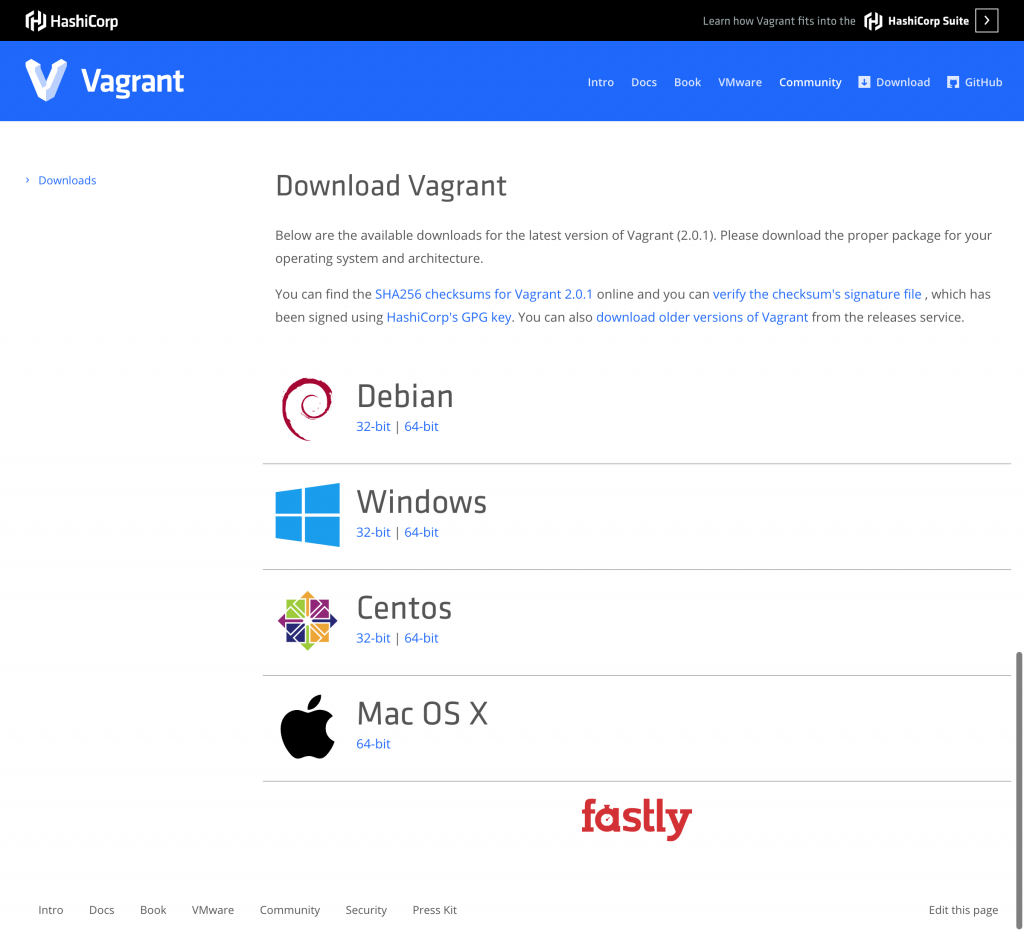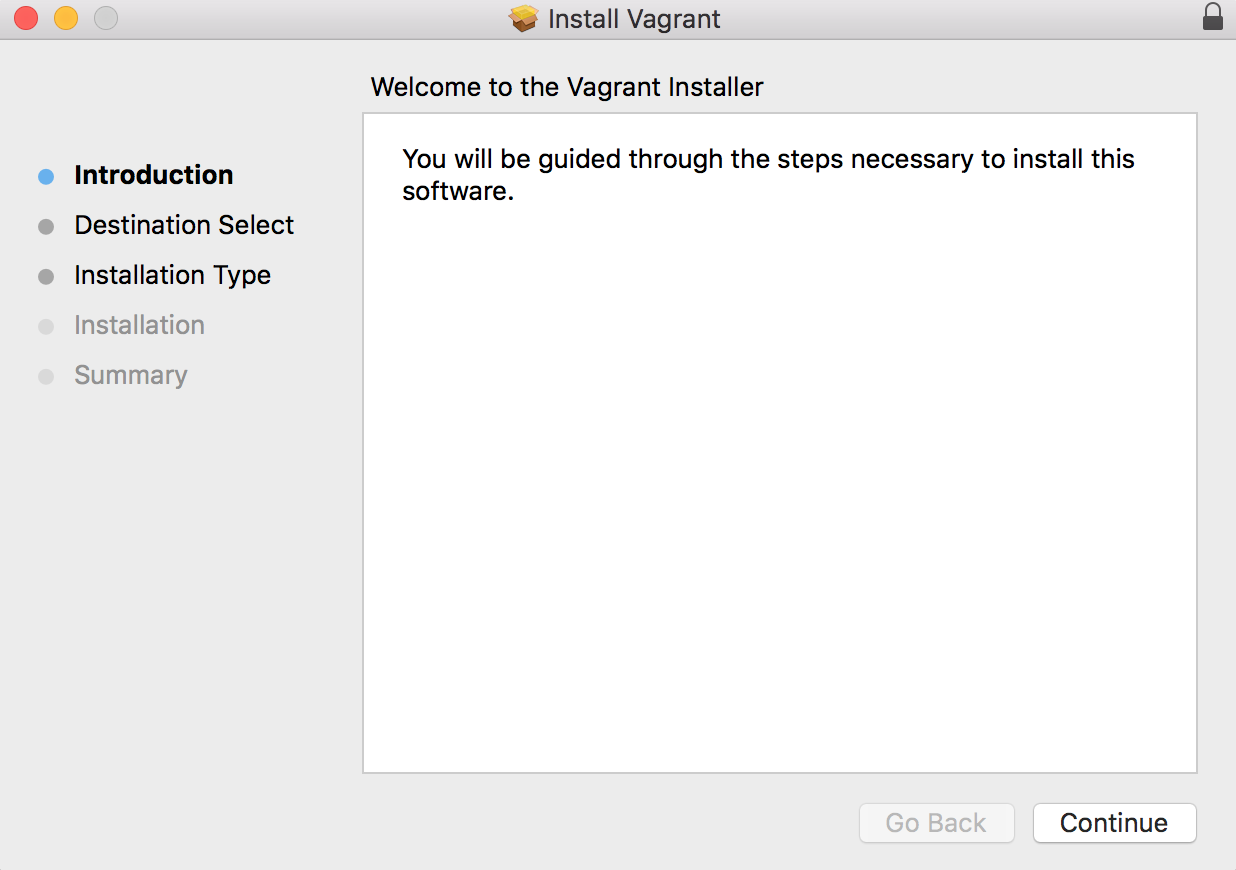Simple and Powerful
- Vagrant For Mac Os Versions
- Vagrant Mac Os Nfs
- How To Install Vagrant
- Download Vagrant For Mac Os
- Vagrant Macos Catalina
HashiCorp Vagrant provides the same, easy workflow regardless of your role as a developer, operator, or designer. It leverages a declarative configuration file which describes all your software requirements, packages, operating system configuration, users, and more.
- $ vagrant init hashicorp/bionic64
- $ vagrant up
- Bringing machine 'default' up with 'virtualbox' provider...
- > default: Importing base box 'hashicorp/bionic64'...
- > default: Forwarding ports...
- default: 22 (guest)
- => 2222 (host) (adapter 1)
- > default: Waiting for machine to boot...
- $ vagrant ssh
- vagrant@bionic64:~$ _
Vagrant Manager shows you which VM's you have up or halted. VM's that are running, have a green indicator, VM's that are off, display a red indicator. HOWTO Run Vagrant with LXC on your Mac. Update: I've since moved from VirtualBox to Parallels, and updated this accordingly.Also, vagrant-lxc has now been upgraded to 0.4.0, which means there are some (very minor) differences. After fooling around with Vagrant and LXC for a few days (thanks to Fabio Rehm's awesome plug-in), I decided to pull everything together into a working. Vagrant provides the framework and configuration format to create and manage complete portable development environments. These development environments can live on your computer or in the cloud, and are portable between Windows, Mac OS X, and Linux. Vagrant is software that is used to manage a development environment. Through the command line, you can grab any available OS, install it, configure it, run it, work inside of it, shut it down, and more. Using VirtualBox and Vagrant, you can simulate the production environment of your app or website.
Production Parity
The cost of fixing a bug exponentially increases the closer it gets to production. Vagrant aims to mirror production environments by providing the same operating system, packages, users, and configurations, all while giving users the flexibility to use their favorite editor, IDE, and browser. Vagrant also integrates with your existing configuration management tooling like Ansible, Chef, Docker, Puppet or Salt, so you can use the same scripts to configure Vagrant as production.
Works where you work

Vagrant works on Mac, Linux, Windows, and more. Remote development environments force users to give up their favorite editors and programs. Vagrant works on your local system with the tools you're already familiar with. Easily code in your favorite text editor, edit images in your favorite manipulation program, and debug using your favorite tools, all from the comfort of your local laptop.

Trusted By
Vagrant is trusted by thousands of developers, operators, and designers everyday. Here are just a few of the organizations that choose Vagrant to automate their development environments, in lightweight and reproducible ways.

Vagrant works on Mac, Linux, Windows, and more. Remote development environments force users to give up their favorite editors and programs. Vagrant works on your local system with the tools you're already familiar with. Easily code in your favorite text editor, edit images in your favorite manipulation program, and debug using your favorite tools, all from the comfort of your local laptop.
Trusted By
Vagrant is trusted by thousands of developers, operators, and designers everyday. Here are just a few of the organizations that choose Vagrant to automate their development environments, in lightweight and reproducible ways.
Well Holy Hannah, I received my first Twitter DM over a blog post I've written. I'm officially a pro now 🧐
The DM was from a user that was having some issues with the instructions I provided on a post I wrote in 2015 for S&W here about how to run the then-current release of macOS inside a Vagrant box.
So I thought, what the heck that blog post is 2 yrs old and in computer time that's pratically middle aged. And Trump's been president for essentially a full year now and let's not even talk about what that's done to the flow of time.
Source: Space.com article, here. Article credits NASA/JPL-CalTech.
tldr - it's worth revisiting, Me Said To Me
Laptop Specs
- 15' 2015 Macbook Pro
- 16 GB of RAM
- 2.8 GHz CPU
- 1 TB SSD
- macOS High Sierra, 10.13.2
Downloads
- macOS High Sierra from the App Store
- Image is approximately 5.2 GB
- latest Vagrant from Hashicorp
- As of this post the latest release is 2.0.1
- Image is approximately 70 MB
- latest release of VirtualBox from Oracle
- As of this post the latest release is 5.2.2
- Image is approximately 93 MB
- Homebrew - a package installer for macOS. Not required but recommended / encouraged.
- iTerm - an alternative to the Terminal app included in macOS. Again, not required but recommended. For the rest of this post 'terminal' can be used interchangeably for iTerm or Terminal, whichever you chose.
Protip: you can install Vagrant and VirtualBox using Homebrew:
- Open terminal
- Install Homebrew (
brew) using the command provided on the link above - Install Vagrant
brew cask install vagrant - Install VirtualBox
brew cask install virtualbox
The main benefit of using a package installer like this is that your packages, like Vagrant and VirtualBox, can now be kept updated with brew update rather than manually downloading / updating package installers from various websites.
For the VirtualBox install you will be prompted to open System Preferences → Security & Privacy at some point. If you don't do this 'fast enough' (by the system's pre-programmed determination) then the install may error out. Fear not! It caches the install like so:
Vagrant For Mac Os Versions
So if the install halts for this reason, or because Connection reset by peer (typically that means slow internet connection), or for any other reason, then you can just hit the up arrow to re-run the last command and hit Enter. Just make sure you fix whatever it asks you to first 😉
What this will essentially look like in terminal:
Documented on my frequently used assets page.
The Gritty Bits
Ok, so now that we have All the Things we need to do ... quite a few steps, actually.
Creating your ISO File
First, when you download High Sierra, or any other macOS release to date, you are downloading the file as a DMG, which is a proprietary Apple disk image format. In order to run macOS in VirtualBox, we'll need to convert the DMG file to a more general format such as an ISO. To do this, we're going to start by converting the installer DMG that we downloaded from the App Store into an image of the full OS, store that in a DMG, and then use a utility called PowerISO to do the final conversion.
If that just read like a paragraph of panic, don't worry! We're going through it step by step.
The output will look like this:
Troubleshooting
What to do if you see the following error:
Vagrant Mac Os Nfs
This most likely means that you've already mounted the InstallESD image. Go into Disk Utility and unmount it:
This likely happened when the High Sierra download completed and immediately opened the installer.
Using your VHD file with VirualBox
Open VirtualBox:
Click New:
Choose a name, Type is 'Mac OS X', and Version is 'macOS 10.13 High Sierra (64-bit)'. Then click 'Continue':
How To Install Vagrant
The default memory is 2 GB, I recommend upping it to 4 GB though if you can:
Download Vagrant For Mac Os
Choose 'Create a Virtual Hard Disk File now' and 'Create':
For the curious
The image manipulations above, with arrow / blurring of text / etc., were done with the Skitch app. You only need an account to save in Evernote - account-less you can just locally save / export to whatever image file format you prefer.
